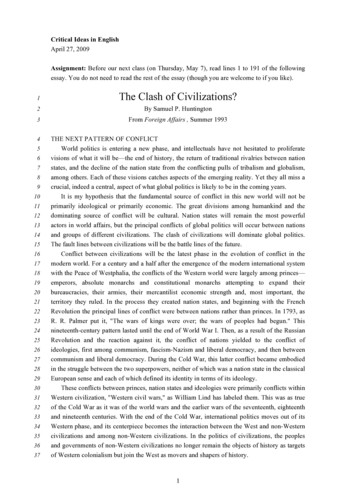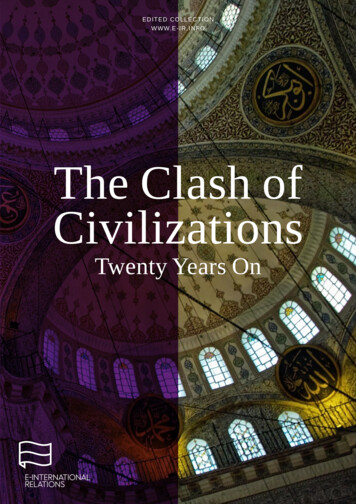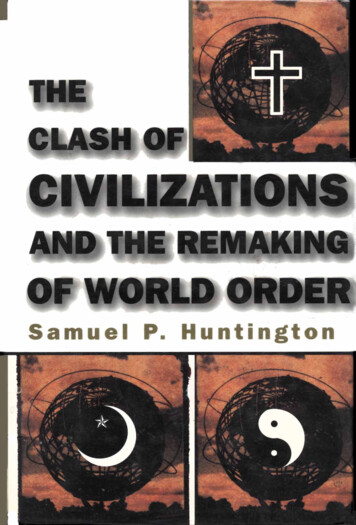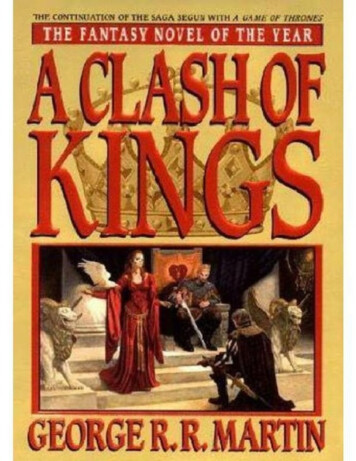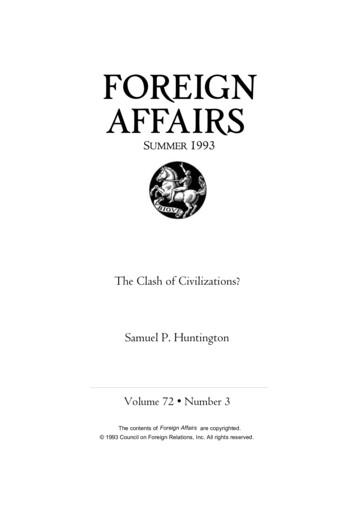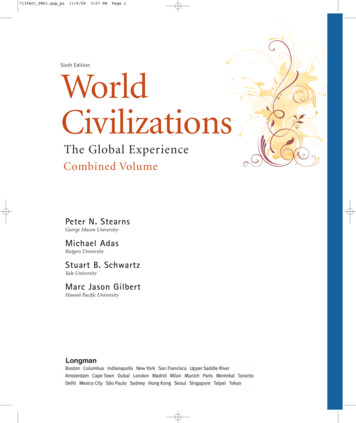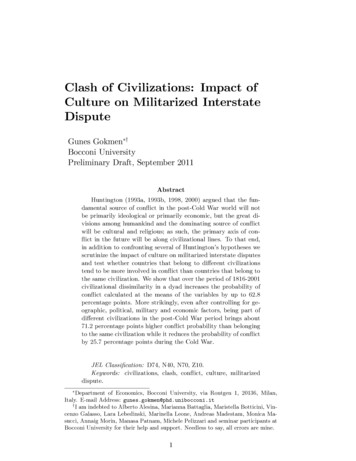
Transcription
Clash of Civilizations: Impact ofCulture on Militarized InterstateDisputeGunes Gokmen yBocconi UniversityPreliminary Draft, September 2011AbstractHuntington (1993a, 1993b, 1998, 2000) argued that the fundamental source of con‡ict in the post-Cold War world will notbe primarily ideological or primarily economic, but the great divisions among humankind and the dominating source of con‡ictwill be cultural and religious; as such, the primary axis of con‡ict in the future will be along civilizational lines. To that end,in addition to confronting several of Huntington’s hypotheses wescrutinize the impact of culture on militarized interstate disputesand test whether countries that belong to di erent civilizationstend to be more involved in con‡ict than countries that belong tothe same civilization. We show that over the period of 1816-2001civilizational dissimilarity in a dyad increases the probability ofcon‡ict calculated at the means of the variables by up to 62.8percentage points. More strikingly, even after controlling for geographic, political, military and economic factors, being part ofdi erent civilizations in the post-Cold War period brings about71.2 percentage points higher con‡ict probability than belongingto the same civilization while it reduces the probability of con‡ictby 25.7 percentage points during the Cold War.JEL Classi cation: D74, N40, N70, Z10.Keywords: civilizations, clash, con‡ict, culture, militarizeddispute.Department of Economics, Bocconi University, via Rontgen 1, 20136, Milan,Italy. E-mail Address: gunes.gokmen@phd.unibocconi.ityI am indebted to Alberto Alesina, Marianna Battaglia, Maristella Botticini, Vincenzo Galasso, Lara Lebedinski, Marinella Leone, Andreas Madestam, Monica Masucci, Annaig Morin, Manasa Patnam, Michele Pelizzari and seminar participants atBocconi University for their help and support. Needless to say, all errors are mine.1
In class and ideological con‡icts, the key question was"Which side are you on?" and people could and did choosesides and change sides. In con‡icts between civilizations, thequestion is "What are you?" That is a given that cannot bechanged. And as we know, from Bosnia to the Caucasus tothe Sudan, the wrong answer to that question can mean abullet in the head. (Samuel P. Huntington, 1993)1IntroductionIn the summer of 1993 Foreign A airs published an article entitled "TheClash of Civilizations?" by Samuel Huntington, which generated a myriad of discussion, controversy, sympathy and antipathy. The articleposed the question whether con‡icts between civilizations would dominate the future of world politics. De ning a civilization as the broadestcultural entity and identity under which people form the highest cultural grouping Huntington (1993a, 1993b, 1998, 2000) claims that in thepost-Cold War era the most fundamental source of con‡ict will be civilizational; therefore, the primary axis of con‡ict in today’s post-ColdWar world will be along cultural and religious lines. Consequently, heconcludes that the greatest threat to world peace are the con‡icts between civilizations.The objective of this study is to scrutinize the impact of culture atlarge on militarized interstate disputes and to confront several of Huntington’s hypotheses from di erent aspects. To that end, we conductanalyses to understand whether countries that belong to di erent civilizations tend to be more involved in con‡ict than countries that belongto the same civilization. We run such tests both on cross-sectional leveland over a panel of years between 1816 and 2001. We also distinguishbetween countries involved in con‡ict of any level and those escalatedto a war and question the validity of indicator of war as a dependentvariable. Moreover, we break down our investigation into Cold Warand post-Cold War periods and take a closer look into Huntington’s hypothesis by making comparisons between these two time periods. Our ndings suggest that civilizational di erences do in fact matter. Overthe entire sample of 1816-2001 we show that civilizational dissimilarityin a dyad increases the probability of con‡ict calculated at the means ofthe variables by up to 62.8 percentage points. More strikingly, once theeconomic factors are taken into account, being part of di erent civilizations in the post-Cold War period brings about 71.2 percentage pointshigher con‡ict probability than belonging to the same civilization whileit reduces the probability of con‡ict by 25.7 percentage points during2
the Cold War.Impact of ethnicity, language, history, tradition, social norms, culture and religion at large on institutions and the economy have long beenstudied.1 In particular, in the context of con‡ict occurrence, there arestudies on both intrastate and interstate con‡ict.2 Fearon and Laitin(2003), for example, suggest that after controlling for per capita income,more ethnically or religiously diverse countries have been no more likelyto experience signi cant civil violence in post-Cold War period. Instead,they propose poverty, political instability, rough terrain and large populations as the factors that explain which countries have been at riskfor civil war.3 On the other hand, Spolaore and Wacziarg (2010) andMartin et al. (2008), among others, study interstate con‡icts. Spolaoreand Wacziarg (2010) examine the theoretical and empirical relationshipbetween the occurrence of interstate con‡icts and the degree of relatedness between countries. Using genetic proximity as a measure of culturaltraits they show that genetically closer populations are more prone togo to war with each other as these populations share closer ideal pointsand a bigger lot of common problematic issues. Martin et al. (2008),instead, emphasize the role trade links play in interstate dispute andshow that while strong bilateral trade relations reduce the probability ofcon‡ict, good multilateral trade relations with third parties increase it.More speci c to the Huntington’s hypothesis, there are as well several studies in the literature that try to tackle Huntington’s thesis fromdi erent angles. Using data from 1820 to 1989 Henderson (1997, 1998)analyze the impact of cultural factors on the relationship between jointdemocracy and war involvement and nds that both ethnic and linguistic1See, for instance, Mauro (1995), La Porta et al. (1999) and Treisman (2000) oninstitutions. Furthermore, Easterly and Levine (1997) and Alesina et al. (2003) areseminal examples illustrating the e ects of ethnic, linguistic and religious fragmentation on the economy through their impact on public policies, infrastructure andproductive public goods. In the latter study, it is also important to note that Alesinaet al. (2003) construct a commonly referred to data set on ethnic, linguistic andreligious fractionalization. As a side note, another index of ethnic and cultural fractionalization commonly used by economists and political scientists alike is by Fearon(2003).2For a review of the recent theoretical literature on con‡ict and appropriationfrom an economic perspective; speci cally, by applying conventional optimizationtechniques and game-theoretic tools to study the allocation of resources among competing activities— productive and otherwise appropriative, such as grabbing theproduct and wealth of others as well as defending one’s own product and wealth seeGar nkel and Skaperdas (2006).3Another example of intrastate con‡ict is Garcia-Montalvo and Reynal-Querol(2002). They argue that index of ethnic polarization predicts civil wars better thanthe index of fractionalization and suggest that di erent measures of heterogeneitymight be needed depending on the question under scrutiny.3
similarity have direct association with war, whereas religious similaritywithin dyads decreases the likelihood of a war; he also nds that wherea pair of states share a common democratic political culture it exerts acon‡ict dampening impact that overrides ethnic, linguistic, or religiousfactors. Russett et al. (2000) and Henderson and Tucker (2001) assessthe incidents of militarized interstate disputes between countries duringthe periods 1950-92 and 1816-1992, respectively. They nd that suchtraditional realist in‡uences as contiguity, alliances, and relative power,and liberal in‡uences of joint democracy and interdependence, providea much better account of interstate con‡ict and intercivilizational dyadsare less, and not more, con‡ict prone. Chiozza (2002) runs an empiricaltest of Huntington’s thesis using Kosimo data between 1946-1997 thatinclude nonviolent con‡ict and shows that state interactions across thecivilizational divide are not more con‡ict prone.4Though all of them are valuable in their own respect, one shouldacknowledge the limitations of the studies described above. First of all,coverage of the post-Cold War period is extremely limited. And Huntington exactly puts his argument forward and makes predictions aboutthe post-Cold War world. Secondly, a direct test of Huntington’s hypothesis based on the classi cation of civilizations by Huntington is not thecentral theme of all of the above studies, but rather an index of ethnic,cultural or religious similarity is used in some of the studies. Thirdly,survey data are also put under scrutiny. Though survey data might giveuseful insights, they rather re‡ect values and beliefs than actual con‡ictitself. Given the amount of limitations su ered by these studies we seeit necessary to confront Huntington’s hypothesis with more recent andmore detailed data taking the basis of civilizations mapped out by him.The remainder of the paper proceeds as follows. In Section 2 wetake a look at what the clash of civilizations hypothesis is and give abrief description. In Section 3 we describe the data set used and themethodology applied for the analyses. Section 4 presents our results.Finally, Section 5 gives some concluding remarks.2What is the Clash of Civilizations Hypothesis?In 1993 Samuel Huntington published his article entitled "The Clashof Civilizations?" in Foreign A airs, in response to Francis Fukuyama’s1992 book, The End of History and the Last Man. His article immediately provoked a lot of controversy and heated debate, and subsequentlybecame one of the most oft-cited articles in the eld of international re4Other related studies are Norris and Inglehart (2002), Mungiu-Pippidi and Mindruta (2002), Bolks and Stoll (2003), Gartzke and Gleditsch (2006) and Jakobsenand Jakobsen (2010).4
lations. Put brie‡y, Huntington (1993a, 1993b, 1998, 2000) argued thatthe fundamental source of con‡ict in the new world (in the post-ColdWar world) will not be primarily ideological or primarily economic, butthe great divisions among humankind and the dominating source of con‡ict will be cultural; as such, the primary axis of con‡ict in the futurewill be along cultural and religious lines.Huntington takes civilizations as the main unit of his analyses. Acivilization is de ned as "a cultural entity, the highest cultural groupingof people and the broadest level of cultural identity people have shortof what distinguishes humans from other species. It is de ned bothby common objective elements, such as language, history, religion, customs, institutions, and by the subjective self-identi cation of people.”5Huntington takes the central de ning characteristic of a civilization asits religion; hence, the major civilizations in human history have beenclosely identi ed with the world’s great religions. These civilizationsoutlined include the Sinic, Japanese, Hindu, Islamic, Orthodox, Western, Latin American, Buddhist and possibly African civilizations plus"lone" countries that do not belong to one of the major civilizations.According to Huntington, inter-civilizational di erences stand out inthe fashion individuals comprehend the relations between God and man,the individual and the group, the citizen and the state, parents and children, husband and wife and also in the weight of importance they put inmatters of responsibility and rights, freedom and authority, and equality and hierarchy. He further claims that these di erences are largelyirresolvable; they are the product of centuries and far more fundamentalthan di erences among political ideologies and political regimes as theyconcern the very self-identi cation of man. People’s identifying themselves with a civilization inevitably implies that they think of themselvesseparately from other civilizations and di erentiate themselves from themembers of other civilizations. To highlight this point, Huntington argues that identity at any level -personal, tribal, racial, civilizational - canonly be de ned in relation to an "other", a di erent person, tribe, race,or civilization. This brings about a group identity in the simple form of"us" and "them" which nurtures clashes with those that are di erent.Huntington (1993, 1998), viewing culture more as a “cause,” suggests that civilizations tend to violence with other civilizations that donot share their culture, worldview, and values. Such violent tendencies,he argues, long held in check by the Cold War, have been unleashed andform the dominant pattern of global con‡ict today and in the future.One theorem that logically devolves from Huntington’s “cultural realist” rendering of “clashing civilizations” is that the degree of cultural5Huntington (1993a), p.23-24.5
dissimilarity between states should predict to the likelihood of con‡ictbetween them. In this view, culturally dissimilar dyads, ceteris paribus,should be more inclined to con‡ict than culturally similar dyads. Assuch, Huntington claims that clashes of civilizations are the greatestthreat to world peace, and that in the post-Cold War world the mostimportant distinctions among peoples are not ideological, political, oreconomic. They are cultural. Although, nation states will remain themost powerful actors in world a airs, world politics at the macro levelare likely to involve con‡icts and shifting power balances of states fromdi erent civilizations, and at the micro level the most violent, prolongedand dangerous con‡icts are likely to be between states and groups fromdi erent civilizations. The clash of civilizations will dominate globalpolitics and the fault lines between civilizations will be the battle linesof the future.As for why civilizations will clash Huntington presents several factors. First, di erences between civilizations are basic and fundamental.Civilizations di er from one another by history, language, culture, tradition, and, most importantly, religion. These di erences are the productof centuries and cannot be easily overcome. Second, the increased interaction among peoples of di erent civilizations makes the world a smallerplace and raises the consciousness and awareness of di erences betweencivilizations and commonalities within civilizations. Third, as economicmodernization and social change throughout the world separate peoplefrom local identities, a resurgence of religious identity is replacing diminishing local and state-based identities. Fourth, increased civilizationconsciousness sparks a return-to-the-roots phenomenon in non-Westernstates. The elites of non-Western societies are going through a deWesternization and indigenization process. Fifth, cultural di erencesand characteristics are less mutable and less easily compromised thanpolitical or economic ones. An example highlights this point. A person can be half-French and half-Arab and a citizen of two countries,but it is more di cult to be half-Catholic and half-Muslim. Finally,increased economic regionalization heightens civilization consciousnessand, in turn, common civilization facilitates the expansion of economicrelations. The interaction of these factors has resulted in the increasedsalience of civilization membership in global politics. Since civilizationalcharacteristics are basic and essential, civilizational di erences are increasingly likely to generate con‡ict.To support his thesis Huntington depicts several real world incidents.For instance, wars such as those following the break up of Yugoslavia,in Chechnya, and between India and Pakistan were cited as evidenceof inter-civilizational con‡ict. To draw attention to the fact that states6
treat other states di erently depending on whether they belong to a similar civilization or a dissimilar civilization, Huntington exempli es thefailure of the West to provide meaningful support to the Bosnian Muslims in the Yugoslavian War or to denounce Croat atrocities in the sameway Serb atrocities were denounced. To highlight civilizations runningup in support of similar civilizations, he points out Russia’s unwillingness to join other U.N. Security Council members in getting the Serbsin Croatia to make peace with the Croatian government, and the o erof Iran and other Muslim nations to provide 18,000 troops to protectBosnian Muslims during the Yugoslavian War. Another example comesfrom the period of the intensi cation of the war between Armeniansand Azeris: Turkish and Iranian demands that the Armenians surrender their conquests, the deployment of Turkish troops to the border andIranian troops across the Azerbaijan border, and Russia’s warning thatthe Iranian action contributes to "escalation of the con‡ict" and "pushesit to dangerous limits of internationalization." Lastly, Huntington makesan example of the U.S. bombings of Baghdad, its virtually unanimoussupport by Western governments, and its condemnation by almost allMuslim governments as another example of the West’s "double standard."3Data and Methodology3.1Measurement of Con‡ictOur data on con‡ict run between 1816 and 2001.6 The indicator ofcon‡ict takes on a value from 0 for no militarized dispute to 5 for highintensity con‡ict that is de ned as an inter-state war with more than1000 total battle deaths. The levels of intensity are classi ed as follows:1 No militarized action, 2 Threat to use force, 3 Display of force, 4 Use of force, and 5 War. In accordance with the literature, we de nean indicator variable taking a value of 1 if the intensity of militarizedcon‡ict is equal to or greater than 3, zero otherwise.7 We treat bothindicator of con‡ict and indicator of war (corresponding to a con‡ictintensity of 5) as dependent variables and run analyses accordingly.Between 1816-2001 there has been an upward trend in the number ofmilitarized con‡ict per year with spikes of World War I and World WarII. We also observe a relative increase starting with early 90’s compared6Our con‡ict data come from the Correlates of War Project. Data for con‡ictare Correlates of War Project, Militarized Interstate Disputes, Version 3.10; which isdescribed in Ghosn et al. (2004) and Ghosn and Bennett (2003). A data set on waris also available as Correlates of War Project, 2011 COW Wars, 1816-2007, Version4.0 (for details see also Sarkees and Wayman (2010)).7For an example, see Spolaore and Wacziarg (2010).7
to rather high but stable levels of con‡ict during Cold War.8 On theother hand, when we look at what part of the militarized disputes iswithin the same civilization and what part is between di erent civilizations, we see that 36 percent of all con‡ict between 1816 and 2001 tookplace between countries that are part of the same civilization; whereas64 percent of the con‡ictual relationships were among di erent civilizational memberships.9 When we break this analysis down to Cold Warand post-Cold War periods, we observe that there is a bigger percentageof inter-civilizational militarized con‡ict during Cold War than duringpost-Cold War, 65 percent compared to 60 percent; which leads us to ahint contrary to Huntington’s thesis.103.2Measurement of Civilizations179 countries are classi ed as members of various civilizations. As described in Section 2 and in Huntington (1998), these civilizations areWestern, Sinic, Islamic, Hindu, Orthodox, Latin American, African,Buddhist and "Lone" States. Construction of civilization membershipis based on Huntington (1998). Accordingly, each country is assigned toa civilization.11Furthermore, country dyads are formed by pairing each country withone another; which resulted in 15931 dyads. To indicate civilizationalheterogeneity within a dyad we construct a variable labeled as "Di erent Civilizations" , DCij ; denoting whether a pair of countries belongto di erent civilizations. This variable is coded as 1 if in a dyad thetwo countries belong to di erent civilizations and as 0 if both countriesbelong to the same civilization. Out of 15931 country-pairs there are2875 pairs for which both countries belong to the same civilization and13056 pairs for which countries belong to di erent civilizations.3.3Other VariablesGeographic Factors Geographical proximity is considered to be oneof the strongest determinants of war. As one of the measures of geographical proximity territorial contiguity is shown to be a strong predictor of con‡ict (Bremer, 1992). The proximity of interactions is likelyto o er both the opportunity and the willingness to engage in con‡ict.Therefore, we take contiguity as one of our independent variables. Ourcontiguity variable takes value one if there is any sort of land or water8Interested reader can consult Figure 1A in the Appendix.See Figure 2A in the Appendix.10See gures 3A and 4A in the Appendix.11See Table 1A in the Appendix for the details of country speci c civilizationalmemberships.98
contiguity between two countries in a pair, zero otherwise.12As in Spolaore and Wacziarg (2010), we also control for additionalgeographic distance metrics such as the measure of the great circle (geodesic) distance between the major cities of the countries13 , latitudinaldistance, longitudinal distance and indicators of geographic isolation andgeographic barriers such as number of landlocked countries in a dyad andthe land area of the countries.14Political Factors Factors which might have contributed to the current state of the institutions and the state of the matters between twocountries go back in history. To control for such historical, politicaland institutional links we include a dummy variable for whether a dyadever had a colonial relationship, i.e. whether one was a colony of theother at some point in time. In addition, we have a dummy variablefor whether a pair of countries have had a common colonizer after 1945,i.e. whether the two countries have been colonized by the same thirdcountry. Furthermore, governing bodies leave their legacy on cultural,historical, political and institutional ties, and this requires inclusion ofa dummy variable to control for whether two countries have been partof the same polity.15Democratic peace argument suggests that democratic countries areless prone to violence and democracy promotes peace (Levy and Razin,2004). We measure the extent of democracy using the 21-point institutionalized democracy scale in a modi ed version of the Polity IV datawhere -10 means a hereditary monarchy and 10 a consolidated democracy.16 As in Martin et al. (2008), we use the sum of the democracyindexes of the two countries in a pair.Di erent legal origins have been shown to have strong implicationsfor institutional outcomes (La Porta et al., 1999). These institutionaloutcomes may, in turn, shape the con‡ict pattern between two countries.Therefore, we create a dummy variable for whether two countries in a12For contiguity data we use Correlates of War Project, Direct Contiguity Data,1816-2006, Version 3.1 (Stinnett et al., 2002). See also Gochman (1991) for additionaldetails.13See Head and Mayer (2002) for details.14These data are compiled by the researchers at the Centre d’Etudes Prospectives et d’Informations Internationales (CEPII). The data are available tm.15These data come as well from CEPII. The data are available tm.16The suggested way of categorization and interpretation of these scores by theproject authors is as follows. Scores from -10 to -6 correspond to "autocracies",from -5 to 5 to "anocracies" and from 6 to 10 to "democracies". The data areavailable at http://www.systemicpeace.org/polity/polity4.htm.9
pair have di erent legal origins. This variable takes value one if the twocountries in a dyad have di erent legal origins, zero otherwise 17Military Factors The idea that an equal-balance of military capabilities deters con‡ict in a contest of arms forces us to control for relativemilitary capabilities of countries (Russet et al., 2000). Therefore, toassess the e ect of states’military capabilities on the likelihood of con‡ict, we use National Material Capabilities data set. The widely-usedComposite Index of National Capability (CINC) index is based on sixvariables in the data set: total population, urban population, iron andsteel production, energy consumption, military personnel, and militaryexpenditure of all state members.18Major military actors are expected to be positively associated withdispute involvement (Chiozza, 2002). Hence, we control for the numberof countries with major power status in a dyad as designated by theauthors of the Correlates of War Project.19Widespread expectations about allies are that they ght each otherless as they are already in agreement regarding their concerns of securityand also allied states often have other political and economic interestsin common (Russet et al., 2000). To control for the in‡uence of allianceson con‡ict, we include a dummy variable for whether a pair of countriesare in some form alliance.20Furthermore, to control for the continuity of con‡ictual relationshipsand the contagion from other disputes we construct two variables. Oneaccounts for the number of peaceful years between two countries sincethe last con‡ict has occurred and the other one takes into account thenumber of other wars in the world in year t:Economic Factors To control for whether income di erences have ane ect on the likelihood of con‡ict, as in Spolaore and Wacziarg (2010),we take into account the absolute value of the log income di erences17Legal origin indicators (common law, French civil law, German civil law, Scandinavian law, and Socialist law) are from La Porta et al. (1999).18We use National Material Capabilites data set Version 4.0 from Correlates ofWar Project. For details see also Singer (1987) and Singer et al. (1972).19Our data come from State System Membership List Version 2008.1 of Correlates of War Project. The designation of major powers also follows COW criteria and includes Austria-Hungary (1816–1918), Prussia/Germany (1816–1918, 1925–1945), Russia/USSR (1816–1917, 1922–), France (1816–1940, 1945–), United Kingdom (1816–), Italy (1860–1943), Japan (1895–1945), United States (1898–), andChina (1949–). China, France, the USA, the UK, and the USSR are classi ed asmajor powers since 1945, as are the German Federal Republic and Japan after 1991.20Alliances data are Version 3.03 from Correlates of War Project (Gibler, 2009;Gibler and Sarkees, 2004). These data originally date back to Singer and Small(1966) and Small and Singer (1969).10
between two countries in a dyad from 1950 on.21One would also need to control for trade relations as economic dependence makes countries less daring when it comes to con‡ict involvement.For instance, Russet et al. 2000 divide the sum of a country’s exportsand imports with its dyadic partner by its GDP to see how much thisbilateral trade relation is economically important. They claim that, aswith the in‡uence of democratic institutions, one expects the likelihoodof a dispute to be primarily in‡uenced by the freedom of action available to the state less constrained from using force. This is the statewith the lower bilateral trade-to-GDP ratio, because it is less dependent economically on trade with the other member of the dyad. On theother hand, Martin et al. (2008) and Spolaore and Wacziarg (2010) takeinto account bilateral openness between a pair of countries and theirmultilateral openness with third parties. Following this stream we usebilateral and multilateral openness together with their interaction withdistance. Bilateral openness is constructed by dividing the trade volumebetween a pair of countries by the GDP of each country and then takingthe average. Multilateral openness, on the other hand, is constructed bydividing the trade volume with third parties of each country in a pairby its GDP and then taking the average.223.4Descriptive StatisticsWe observe in Table 1 the number of con‡icts across and within civilizations and their share in total number of con‡icts between 1816 and 2001.On-diagonal entries correspond to the con‡icts which have happenedbetween countries that are members of the same civilization; whereaso -diagonal elements are the con‡icts between countries that belong todi erent civilizations. This table gives us a better understanding ofwhat part of the con‡icts are inter-civilizational and what part intracivilizational; moreover, we get a sense of what civilizations have morecon‡ictual relationships than the others.We observe many on-diagonal elements; which tell us that there isa myriad of intra-civilizational disputes, though the numbers are muchsmaller than o -diagonal entries. By looking at intra-civilizational disputes the most combat prone civilizations seem to be Western and Islamic civilizations followed by a high degree of con‡ict among LatinAmerican countries with 9.5, 7.9 and 6.8 percents of all con‡ict, respectively .21For income data we use Penn World Tables Version 6.2 available athttp://pwt.econ.upenn.edu/php site/pwt index.php.22Trade data come from Correlates of War Project, Trade Data Set, Version 2.0.See also Barbieri et al. (2008, 2009).11
TABLE 1. Number of Conflicts within and across Civilizations between 1816-2001.CivilizationsWesternWestern419 (9.5%)SinicIslamicSinic265 (6%)Islamic581 (13.1%)15 (.34%)351 (7.9%)Hindu5 (
bullet in the head. (Samuel P. Huntington, 1993) 1 Introduction In the summer of 1993 Foreign A airs published an article entitled "The Clash of Civilizations?" by Samuel Huntington, which generated a myr-iad of discussion, controversy, sympathy and antipathy. The article posed the question whether con icts between civilizations would domi-

